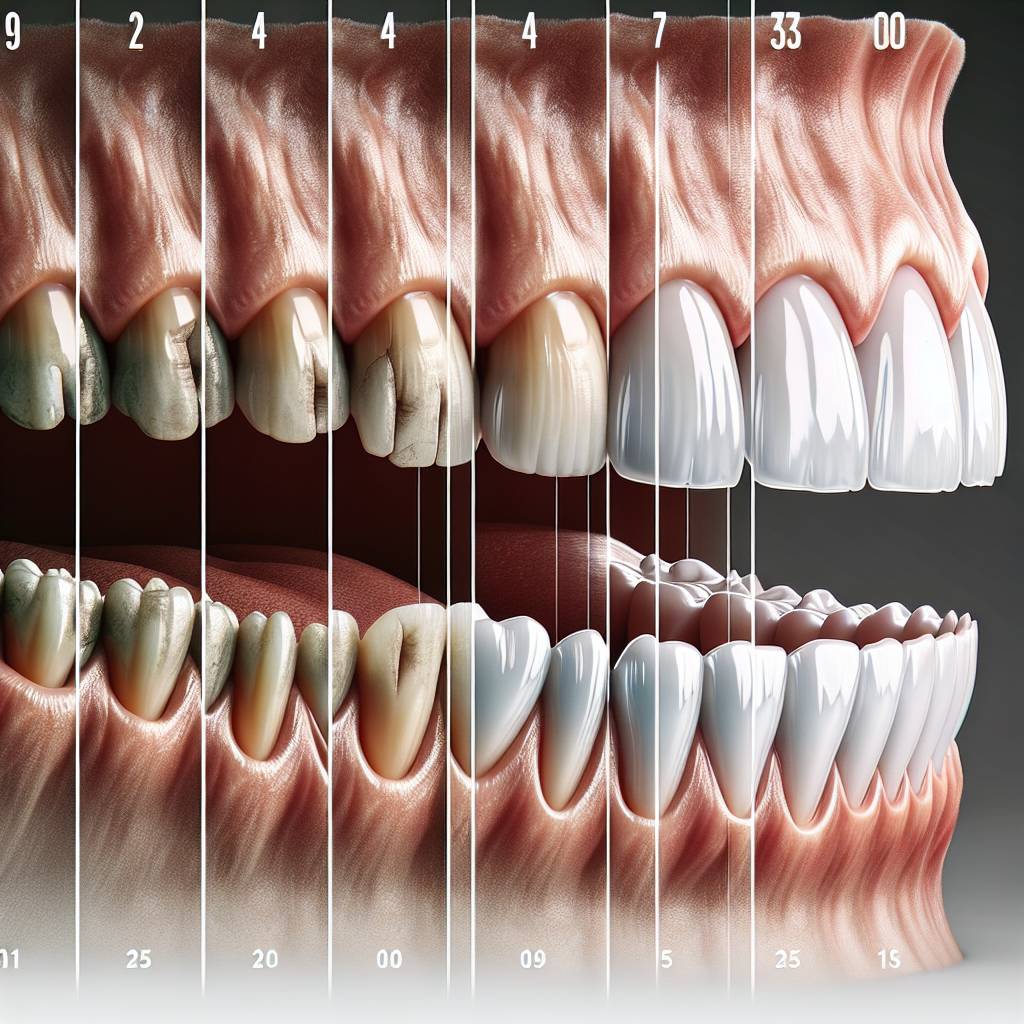Crooked teeth can be a source of embarrassment and insecurity, but with the advancements in orthodontic treatments, it is now possible to straighten your teeth quickly and effectively. But how long does it take for crooked teeth to straighten? The answer depends on a variety of factors including the severity of the misalignment, type of treatment chosen, and patient compliance. In general, it can take anywhere from six months to two years for crooked teeth to straighten.The length of time it takes to straighten crooked teeth depends on the severity of the individual’s misalignment, as well as the type of treatment they choose to undergo. In general, braces can take anywhere from six months to two years to straighten teeth, while clear aligners may take between one and two years.
Factors Determining the Length of Time for Teeth Straightening
The length of time required to straighten teeth can vary depending on the severity of the misalignment, the type of treatment being used, and the patient’s overall oral health. The most common type of orthodontic treatment, traditional metal braces, typically require 18-36 months to complete. However, more severe cases may require up to 48 months to achieve optimal results.
Other types of orthodontic treatments, such as clear aligners or ceramic braces, can often be completed within 12 months. Clear aligners are customized plastic trays that are changed out every two weeks and gradually move the teeth into position. Ceramic braces provide a more aesthetic appearance than metal braces but have a longer treatment time due to their larger size.
The patient’s overall oral health also plays a role in determining how long it will take for teeth straightening treatments to be successful. If there is extensive decay or gum disease present, it will need to be treated prior to beginning orthodontic treatment. This may require additional visits with a dentist before starting orthodontic treatment and can add additional time to the overall treatment process.
Finally, how well the patient follows instructions and maintains their orthodontic appliances also affects the duration of treatment. After each visit with an orthodontist, patients will receive instructions on how often they should wear their appliances and what activities should be avoided while wearing them. If these instructions are not followed properly or if patients do not keep their appointments regularly, this can add additional time onto their treatment plan.
Traditional Braces
Traditional braces are the most common way to straighten teeth. These metal brackets are attached to the front of the teeth and connected with a wire. The wire is adjusted over time to move the teeth into place. Traditional braces can take anywhere from six months to two years, depending on your individual situation. They are often the least expensive option, but they can be uncomfortable and require regular trips to the orthodontist for adjustments.
Invisalign
Invisalign is a popular alternative to traditional braces that uses clear plastic aligners instead of metal brackets and wires. The aligners need to be worn for 20-22 hours per day and should be changed out every two weeks or so as your teeth move into place. Invisalign is more comfortable than traditional braces and can take anywhere from 12 months to two years, depending on how much movement is needed. However, it tends to be more expensive than traditional braces.
Ceramic Braces
Ceramic braces are similar to traditional metal braces, except that the brackets are made of a clear or tooth-colored material that blends in with your natural teeth color. This can make them less noticeable than traditional metal braces. Ceramic braces work in the same way as traditional metal braces, but they need more attention when it comes to cleaning since they can become stained easily. They usually take about the same amount of time as traditional metal braces.
Lingual Braces
Lingual braces are similar to traditional metal braces except that they are placed on the backside of your teeth instead of the front side. This makes them virtually invisible when you smile and talk, making them a popular option for adults who want straighter teeth without anyone knowing they’re wearing braces. Lingual brackets can be more difficult to clean than other types of braces and may take longer than other types since it takes longer for movement in back teeth compared with front teeth.
Self-Ligating Braces
Self-ligating braces use a sliding door mechanism instead of elastic bands or steel ties to hold the archwire in place on each bracket. This type of brace is designed so that you don’t need regular visits for tightening like you would with traditional or ceramic braces because there’s no need for tightness adjustments throughout treatment. Self-ligating brackets tend to be smaller than other types of brackets which makes them less noticeable and they typically require fewer office visits which reduces treatment time.<
How Effective are Teeth Straightening Treatments?
Teeth straightening treatments can be very effective when administered properly and depending on the severity of the malocclusion. Orthodontic treatments such as braces, clear aligners, and retainers, can all be used to correct misalignment problems. Braces work by using metal brackets and wires to gradually move the teeth into the desired positions. Clear aligners are custom-made trays that fit over the teeth and are designed to gradually move the teeth into position. Retainers are typically worn for a few hours a day and help keep the teeth in their new position after braces or aligners have been removed.
The effectiveness of any teeth straightening treatment will depend on how well it is administered and how severe the misalignment is. Braces typically take between one to three years to complete treatment, while clear aligners may take up to two years. For mild cases of misalignment, retainers may be all that is needed to correct the problem. In more severe cases, a combination of treatments may be necessary for optimal results.
Overall, teeth straightening treatments can be very effective when administered properly and depending on the severity of the malocclusion. It is important to discuss your specific needs with your orthodontist before beginning any treatment plan in order to ensure that you receive optimal results.
Cost of Teeth Straightening Treatments
The cost of teeth straightening treatments will vary depending on the type of treatment you choose and how complex your case is. Traditional braces can cost anywhere from $3,000 to $7,000. Invisalign can range from $4,000 to $8,000. Clear aligners such as Smile Direct Club and Candid Co typically range from $1,900 to $3,000. Lingual braces require specialized training and therefore are the most expensive option with prices ranging from $8,000 to $10,000.
It is important to note that each case is unique and may require varying amounts of time in order to achieve the desired results. Therefore, it is important to consult with a qualified orthodontist who can provide an accurate estimate based on your individual needs. Additionally, many orthodontists offer payment plans or financing options so that you can spread out the cost over a longer period of time.
In addition to the cost of treatment itself, there may be additional fees associated with teeth straightening treatments such as office visits and X-rays. It is important to ask your orthodontist about any additional fees that may apply before beginning treatment so that you are not surprised by unexpected charges down the line.
Overall, the cost of teeth straightening treatments can vary significantly depending on your individual needs and which type of treatment you choose. It is important to consult with a qualified orthodontist who can assess your case and provide an accurate estimate based on the complexity of your condition. Additionally, many orthodontists offer payment plans or financing options so that you can spread out the cost over a longer period of time.

Does Age Affect the Length of Time for Teeth Straightening?
The length of time for teeth straightening can vary depending on a number of factors, including age. Generally, younger patients require less time to achieve the desired results than older patients do. This is because younger patients have more malleable bones and teeth, and this makes it easier to move them into the desired position. As a person ages, their bones become harder and more rigid, making it more difficult to adjust them into place.
Another factor that affects the length of time needed for teeth straightening is the severity of the misalignment. If there is only a minor misalignment, then this can usually be corrected in a shorter period of time than if there is a major misalignment. In addition, some types of teeth straightening treatments may take longer than others depending on how complex they are. For example, braces may take longer to correct than clear aligners due to their complexity and need for frequent adjustments.
At the end of the day, age does play a role in how long it takes to achieve successful teeth straightening results. However, it is important to remember that each individual case is different and that other factors such as severity and type of treatment also come into play when determining how long it will take to get your teeth looking great. It is best to speak with your orthodontist or dentist about what you can expect in terms of time frames for your specific situation.
Minimizing the Length of Time for Teeth Straightening
Straightening teeth can be a lengthy process, but there are steps you can take to minimize the time it takes. The most important factor in decreasing the time it takes to straighten teeth is to follow your orthodontist’s instructions closely. This means wearing your aligners or braces for the recommended amount of time each day and attending all recommended check-up appointments.
In addition, keeping your teeth and gums clean and healthy can help speed up the process. Brush and floss regularly to maintain good oral hygiene, and make sure to follow your dentist’s instructions on how to care for your teeth while wearing braces or aligners.
If you need orthodontic treatment that requires more advanced technology, such as clear braces or Invisalign, discuss with your orthodontist if they offer any time-saving options such as accelerated braces. Accelerated braces use technology that helps move teeth more quickly than traditional braces.
Finally, ask your orthodontist about any additional methods that may speed up the process of straightening teeth. Your orthodontist may recommend adding bite accelerators or other treatments that can help reduce treatment time.
Overall, following your orthodontist’s instructions carefully and taking any additional steps recommended by them will help minimize the length of time required for teeth straightening.
Is There Any Risk Involved in Teeth Straightening Treatments?
Straightening teeth can be a great way to achieve a more attractive smile and boost self-confidence. However, as with any dental treatment, there are some risks involved. Before undergoing any orthodontic treatment, it is important to understand the potential risks and how they can be minimized.
Common risks include gum irritation, damage to the teeth or gums, and tooth discoloration. Gum irritation is usually caused by braces or retainers rubbing against the gums, resulting in inflammation and soreness. This can be minimized by brushing regularly with a soft-bristled toothbrush and using an antibacterial mouth rinse to reduce plaque buildup. Damage to the teeth or gums can occur if the orthodontic hardware is too tight or too loose; this can be prevented by having regular checkups with your orthodontist so they can adjust the braces or retainers as needed.
Tooth discoloration may also occur if certain foods are eaten while wearing braces or retainers. To prevent this from happening, it is important to avoid foods that are hard or sticky, such as candy or popcorn kernels. It is also important to brush your teeth after every meal to remove any food particles that may become trapped in the orthodontic hardware.
Although these risks are possible with any type of orthodontic treatment, they are typically minor and easily manageable when following proper care instructions from your orthodontist. By taking precautionary measures and following their advice closely, you can minimize your risk of experiencing any of these issues while undergoing teeth straightening treatments.

Conclusion
The time it takes to straighten crooked teeth with orthodontic treatment can vary depending on the severity of the misalignment, the type of treatment used, and the patient’s individual anatomy. In most cases, traditional braces are used to straighten teeth in 18-36 months. Invisalign can take anywhere from 6-18 months depending on the complexity of the case. Other treatments such as tooth reshaping and veneers can also be used to improve minor misalignments and deliver results quickly.
Overall, it is important to consult with an experienced orthodontist who can provide a comprehensive evaluation and discuss all available treatment options that are best suited for your individual needs. With commitment and patience, you can achieve a beautiful smile with straighter teeth.

